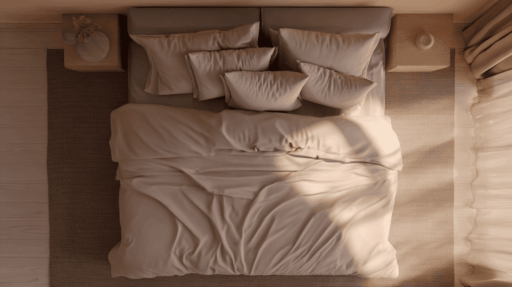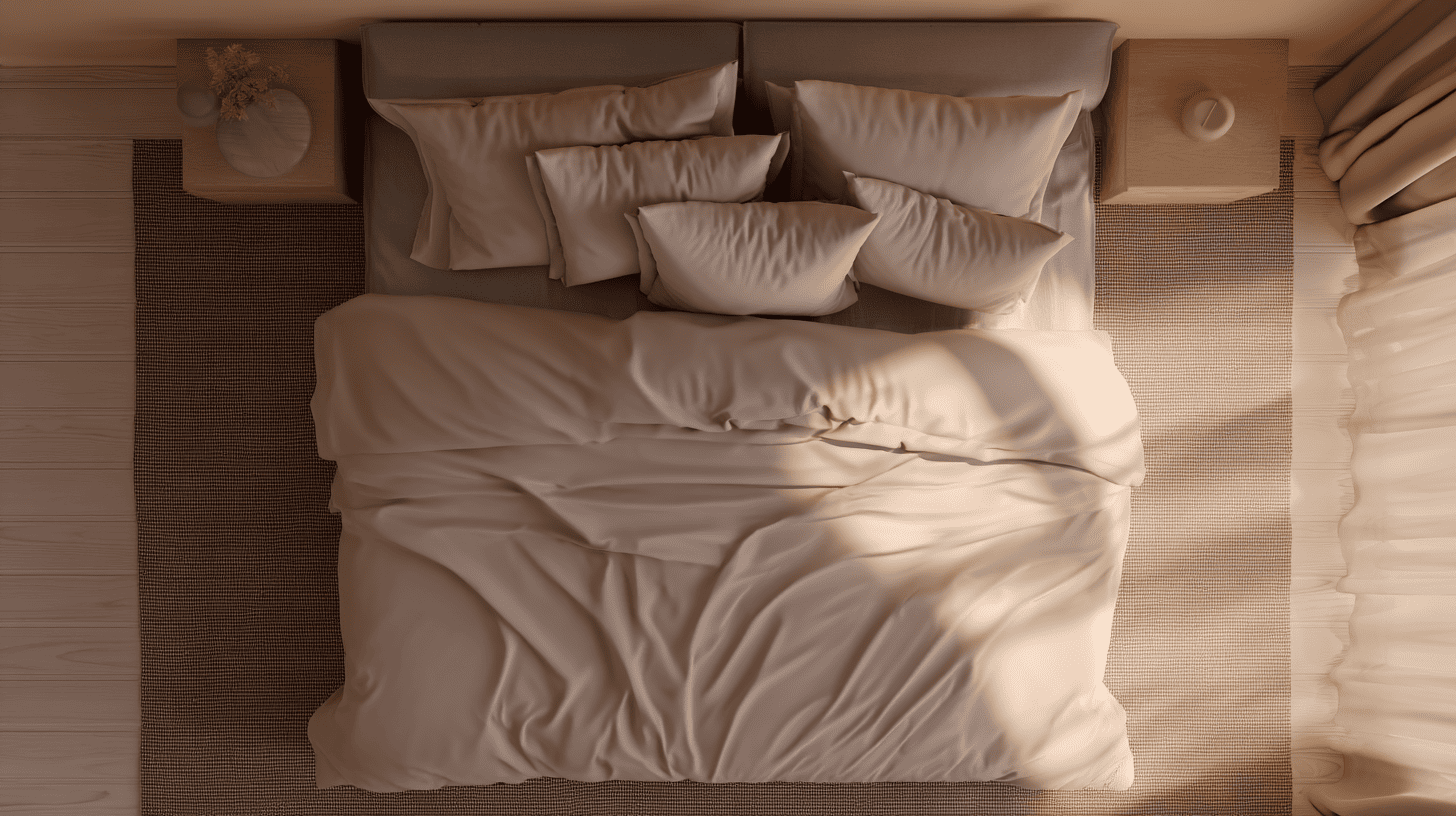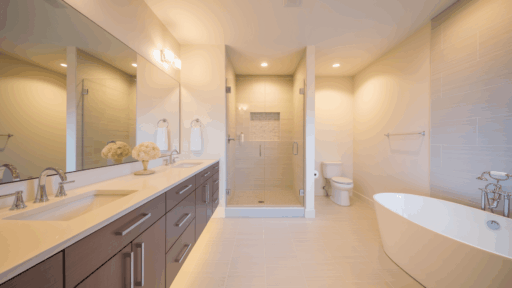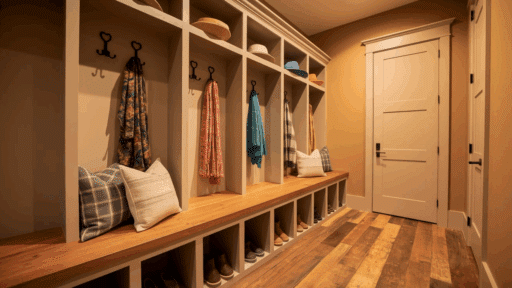Picking the right mattress size matters a lot! You want enough room to stretch out and sleep comfortably, but you also don’t want your bed taking up your whole bedroom.
If you’re thinking about getting a queen bed, you’re in good company. Queen beds are super popular because they give you space to move around and still fit nicely in most rooms.
In this guide, we’ll explain everything you need to know about queen size bed dimensions, especially queen size bed dimensions in feet, so you can be sure it’ll fit your space and needs.
We’ll keep things simple with step-by-step tips, room layout ideas, and easy comparisons so you can choose a mattress that feels great and fits your room perfectly.
Queen Size Bed Dimensions and Common Variations in Feet
A standard queen-size mattress is 60 inches wide and 80 inches long, which is approximately 5 feet wide by 6 feet 8 inches long. In metric, it comes to roughly 152 cm by 203 cm.
This size is ideal for two adults, providing ample room to sleep without occupying your entire bedroom. It offers a nice middle ground, more space than a full, but not as bulky as a king or California king. That’s why it works so well in master bedrooms, guest rooms, and even some larger studio spaces.
Common Queen Size Variations:
Besides the standard queen, there are a couple of popular variations that give you a little more room in specific ways:
- Olympic Queen (5.5 ft × 6.66 ft): This one is 6 inches wider than a standard queen. It’s a good choice for couples who want more space to spread out but don’t have room for a king-size bed.
- California Queen (5 ft × 7 ft): This version features an additional 4 inches in length. It’s ideal for taller sleepers who find regular queen beds just a little too short.
Both versions still fit in most medium-to-large bedrooms, but it’s always a good idea to measure your space first.
Whether you need more width, more length, or simply a comfortable fit that accommodates your furniture, queen beds are flexible enough to meet your needs.
How to Choose the Right Queen-Size Mattress for Your Room
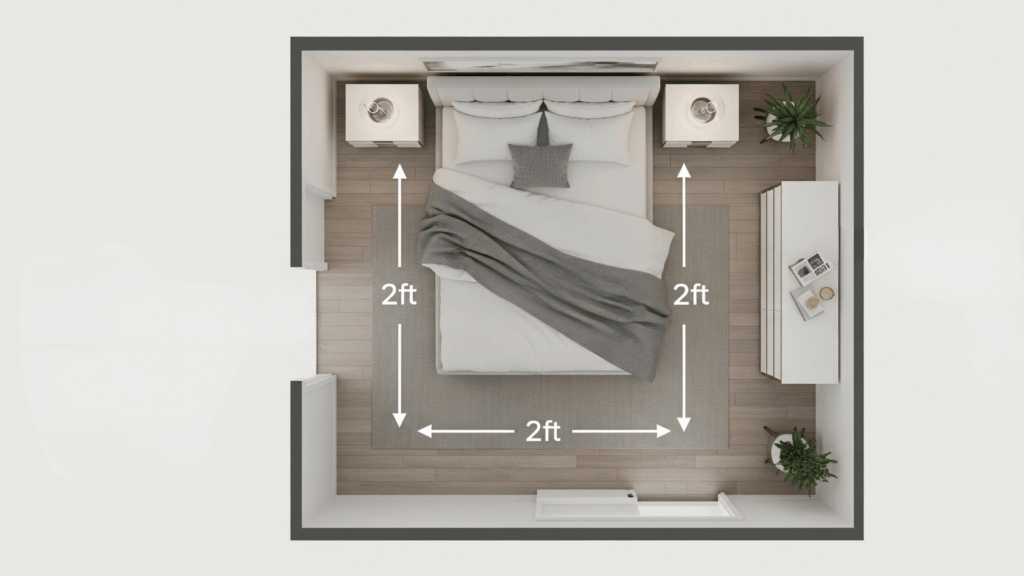
Choosing the perfect queen mattress starts with understanding your space and needs. Follow these simple steps to find the right fit for your room.
Step 1: Measure Your Room
Accurately measuring your bedroom dimensions is the first crucial step for fitting a queen-size bed.
- Use a measuring tape to determine the length and width of your room.
- Ensure your room is at least 10 feet by 10 feet to accommodate a queen-size mattress comfortably.
Proper measurements help you plan your space effectively for a comfortable and functional bedroom layout.
Step 2: Plan for Walking Space
Maintaining sufficient open space around your queen bed ensures ease of movement and optimal room functionality.
- Maintain at least 2 feet of clear walking space on each side of your mattress wherever possible.
- This buffer lets you move freely, make your bed, and easily access nightstands nearby.
Sufficient walking space prevents a cramped feeling and makes daily routines much smoother.
Step 3: Factor in Mattress Thickness & Bed Frame Style
Both the mattress’s thickness and the style of the bed frame influence the layout of your bedroom.
- Thicker mattresses and taller bed frames (like platforms or ones with box springs) add to the bed’s overall height and footprint.
- Ornate frames or higher beds may require additional clearance above or around the sleeping area.
Considering bed height and style helps you avoid overcrowding and ensures your desired aesthetic.
Step 4: Account for Headboards and Storage
Extra furniture features, such as headboards and built-in storage, can impact your available room space.
- Large headboards or frames with storage drawers require additional space against the wall and beside the bed.
- Always check the total depth and width of such features to ensure they fit within your layout.
Factoring these elements in advance prevents surprises and streamlines your room setup.
Step 5: Arrange Other Furniture
Proper furniture placement creates a comfortable, usable bedroom environment.
- Plan where nightstands, dressers, or desks will sit in relation to your bed for easy access.
- Ensure these items don’t block walkways or occupy your sleeping space.
A well-arranged bedroom ensures it feels open and functions well to meet your needs.
Step 6: Visualize Before Buying
Previewing your room layout helps you make confident decisions about bed and furniture placement.
- Use painter’s tape or cardboard templates to outline the bed and key furniture on your floor.
- This provides a realistic idea of how much space your queen bed and accessories will occupy, allowing you to adjust the layout as needed.
Visualizing beforehand helps avoid measurement mistakes and supports a well-organized bedroom.
Queen Size Bed Dimensions vs. Other Mattress Sizes
Before deciding on a queen bed, it’s helpful to compare its dimensions with those of other standard mattress sizes, such as twin, full, king, and California king, to find the best match for your space and comfort.
| Mattress Size | Width (ft) | Length (ft) | Ideal For |
|---|---|---|---|
| Twin | 3.25 | 6.25 | Kids, small rooms |
| Full (Double) | 4.5 | 6.25 | Single sleepers wanting more space |
| Queen | 5 | 6.66 | Couples or individuals, versatile |
| King | 6.33 | 6.66 | Larger bedrooms, more space |
| California King | 6 | 7 | Taller sleepers need extra length |
A queen-size is often preferred because it provides enough room for two people without overwhelming an average-sized bedroom.
Tips For Purchasing a Mattress
When choosing a queen-size mattress, understanding key practical tips related to its dimensions can help you make the best decision for comfort, compatibility, and a well-fitting bedroom.
- Standard Bedding is Easy to Find: Queen mattresses work with most sheet sets, comforters, and blankets.
- Great for Room Sharing: Big enough for two people or even a pet, without feeling cramped.
- Fits Many Spaces: Works well in master bedrooms, guest rooms, or larger studio apartments.
- Custom Comfort Options: Many brands offer different firmness levels without changing the actual size.
- Easier to Move Than King Size: Queen mattresses are simpler to maneuver through doorways and up stairs than larger beds, especially in apartments or tight spaces.
- Better Value for Most Households: Queen mattresses often offer the best balance of price, space, and comfort, making them a budget-friendly choice for many buyers.
Keeping these tips in mind will help you select the right queen mattress that balances comfort, style, and practical needs for your living space.
Wrapping it Up
Knowing the queen size bed dimensions, and especially understanding the queen size bed dimensions in feet, is key to making a wise choice. A standard queen offers a great mix of room to stretch out without overwhelming smaller bedrooms.
It’s a wise choice for couples, solo sleepers, guest rooms, and even growing teens. Before buying, take the time to measure your room, consider how you use the space, and compare mattress options.
Picking the right size helps you sleep better, stay organized, and feel more comfortable in your room, night after night. A little planning goes a long way.
Frequently Asked Questions
1. What Is the Ideal Ceiling Height for A Bedroom with A Queen-Size Bed?
While bed size primarily affects floor space, a ceiling height of at least 8 feet is recommended for optimal ventilation and to prevent feeling cramped, especially with taller bed frames or canopy beds.
2. How Much Storage Space Can I Add Under a Queen-Size Bed?
Storage options under queen beds depend on frame style. Platform beds may have drawers or open space, but thicker mattresses or box springs can reduce space. Measure your frame and mattress height before purchasing storage.
3. Can a Queen Bed Fit Comfortably in A Room Smaller than 10×10 Feet?
Technically, yes, but it leaves little space for walking or furniture. Using minimal bed frames or wall-mounted furniture helps optimize small areas, but rooms under 100 sq ft are better for full or twin beds.
4. How Does Mattress Thickness Affect Overall Bed Size and Room Feel?
Mattress thickness typically ranges from 6 to 14+ inches and adds to the bed’s height and perceived bulk. Thicker mattresses add comfort but can make the bed feel larger and more complex to get in/out of for some users.

